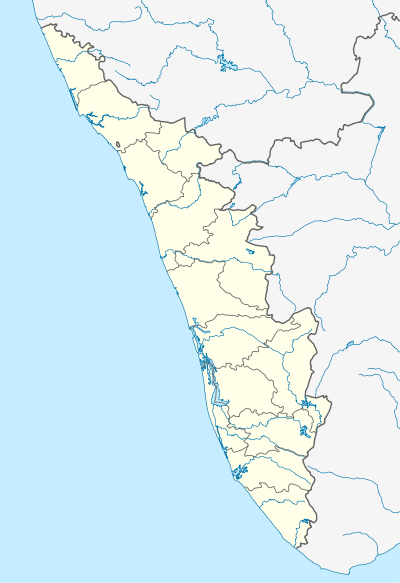Kumbalangy
| Kumbalangy | |
|---|---|
| village | |
 Kumbalangy Location in Kerala, India | |
| Coordinates: 9°52′47″N 76°17′01″E / 9.879770°N 76.283530°ECoordinates: 9°52′47″N 76°17′01″E / 9.879770°N 76.283530°E | |
| Country |
|
| State | Kerala |
| District | Ernakulam |
| Population (2001) | |
| • Total | 40,331 |
| Languages | |
| • Official | Malayalam, English |
| Time zone | IST (UTC+5:30) |
| PIN | 682007 |
| Vehicle registration | KL-7 / KL-43 |
| Nearest city | Kochi |
Kumbalangy is a suburb of the city of Kochi, in the state of Kerala, India, located in the district of Ernakulam.
Location and geography
|
Kumbalangy is an island-village on the outskirts of Cochin city. The village is 16 km2 in area. Kumbalangy is 15 km. from the South Railway Station and 45 km. from the Kochi International Airport.
Population and economy
Nearly 1,00,000 people live in the village. The main occupation in Kumbalangy is fishing, and there are over 100 Chinese nets in the backwaters that face the village. Groves of mangroves separate land from water providing a breeding ground for prawns, crabs, oysters and small fishes. It is home to fishermen, farmers, labourers, toddy tappers and coir spinners.
An occupation that's seen quite a revival is that of boatmen. The village is well connected by road to the mainland, and the local community did not patronize them very much. However, tourists are keen on cruises. Fisher folk and boatmen also demonstrate various fishing techniques for the tourists.
Model tourism village
In 2003 Kerala government selected several Indian villages as model villages. The Kumbalangy Integrated Tourism Village project is meant to transform the tiny island into a model fishing village and tourism spot. The panchayat (village council) - with financial assistance from the state government - is implementing the project.
"The Kumbalangy project was set in motion in 2003 to help the local people, the economy and the locality through tourism," says M C Sivadathan, President of the Kumbalangy panchayat. "And in order to achieve this, we have done away with many concepts typical of tourism elsewhere. Our idea is to create job opportunities for the villagers, while also ensuring that tourists have a good time seeing and experiencing real village life, he explains.
Currently, there are about 10 houses that offer rooms to visitors. This facility is generally within a residence, where two or more rooms with attached baths are set aside for guests. The tourists sit with the host family and eat the same food they eat. They can walk through the village, watch fisher folk at work, fish themselves, go canoeing and visit the farms, among other things. They can also contact the panchayat if they require assistance.
Many people also wondered whether Kerala food would be palatable to foreign taste buds. The result, though, has been extremely satisfactory. "Other than making the food less spicy, we do not deviate from traditional cuisine," says Lilly Lawrence, who supervises cooking in the Retreat. "There is a huge demand for fish and seafood, such as prawn and shrimp. Everything is available locally," she says. Lawrence recalls, "Initially, we were worried about whether guests would like the village and its rustic ambience. But we realized that this is a novel experience for them. We have had tourists who stayed with us for weeks, reading books, fishing or simply watching the backwaters." Tourists also find that there is no huge communication gap, because at least one member in a family, if not all, can converse in English.
Artists' village
Under the Kumbalangy project, Kalagraamam, an artists' village, is also being set up. The initial plans were to erect a cottage in the middle of the backwaters. Later, the panchayat members, tourism secretary and the tourism minister were all agreed that this would disturb the backwaters ecology. Kalagraamam, therefore, will now stand on four acres of land inside Kumbalangy. It will showcase the traditional fishing equipment and handicrafts of the region.
Pokkali farming
Another goal the project has is to bring the village back to a time when it was more ecologically balanced - about 25 years ago. Towards this, pokkali farming, a crop pattern that alternates between rice and fish (each for six months a year), is being brought back in full form. Also, mangroves that were once in abundance in the region are being planted once again. So far, about 50,000 mangrove saplings have been planted in the area. "We used to have plenty of fish here because of the mangroves. The planting of mangroves will lead to a better environment for the fish to live in" says Sivadathan.
Infrastructure
The Kumbalangy panchayat is well aware that being a tourist destination also brings with it greater responsibilities. "Tourists will not come unless there are proper roads and lights. So, the roads and canals have been strengthened, CFC lamps have been installed, and 600 biogas plants have been set up for waste management. Kumbalangy is also the first panchayat in the state to set up such a waste management system. A park has also been constructed for visitors to relax in. The most remarkable thing about this project is that what we do for the tourists also directly benefits the local population," Sivadathan says.
References
| Wikimedia Commons has media related to Kumbalangi. |
